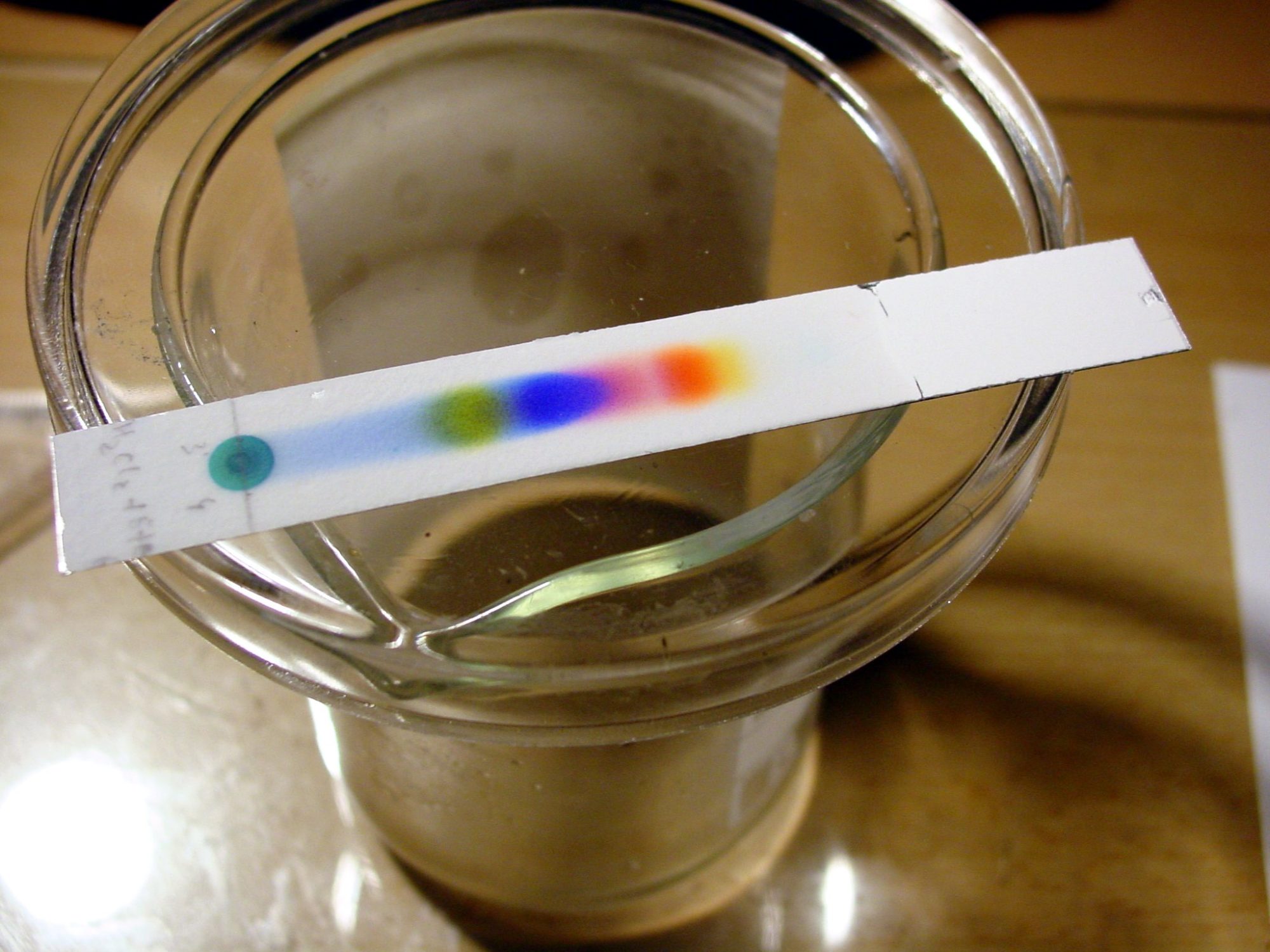Step 1
Place four separate drops of water on the plate and on each drop place one candy, each candy should be a different colour.
Step 2
Let them stand for 5 minutes or until the water droplets become coloured by the candy.
Step 3
Cut the filter paper into rectangular strips.
Step 4
Draw a horizontal line at the bottom of the filter paper and mark four equidistant dots on the line with a pencil.
Step 5
Place some table salt in the glass jar and fill it to about 2 cm with water.
Step 6
Mix the contents of the glass jar until the salt is dissolved.
Step 7
Dip a toothpick in one of the coloured water drops and apply a small drop of dyed water to one of the dots on the filter paper with the tip of the toothpick.
Step 8
Repeat this three times for the same colour.
Step 9
Repeat step 6 and step 7 for the other three colours using a different toothpick for each different colour.
Step 10
Attach the filter paper to a pencil using a paperclip or tape.
Step 11
Put the filter paper in the glass jar and the pencil on the top of the jar. Make sure that the pencil line is just above the water.
Step 12
Leave the filter paper in the glass jar for a few minutes until the water approaches the top of the filter paper.
Step 13
Compare how far each colour has moved up the filter paper.
Candy can be replaced by other things such as non-permanent markers, coloured pens and food colouring.
A transparent cup can be used instead of a glass jar.
Instead of a laboratory filter paper, coffee filters can be used but these will not have as good results as the former.
Help keep our environment clean by reducing waste, reusing materials, and recycling whenever possible!
Make sure that the line containing the coloured dot is above the water level.
The idea of how chromatography works can be related to the following analogy. Let’s imagine having a river of flowing water that is transporting sand, small rocks and larger rocks from one location to another. The sand is small and remains flowing with water so it is easily transported from one point to another. The small and the larger rocks sink to the bottom. This makes it more difficult for them to be moved by the water and hence, take it takes much longer for the rocks to be transported the same distance as the sand.
Imagine being a detective at a crime scene, and after searching the area, you found a note written in pen. There are three individuals that are suspects in the crime scene. Each suspect carries a pen on them, therefore, by comparing the chromatogram of the ink of the pen from every person with the chromatogram of the ink found at the crime scene, one can determine if any of the suspects wrote the note.
Why draw the bottom line with a pencil and not with a pen?
The ink of the pen would dissolve and mix with the coloured spot from the candy.
The spots on the pencil line are to be above the water. Why?
If the spots are immersed, the colour mixes with the liquid in the jar rather than move up the filter paper.
Why is it important that separate toothpick is used for every colour?
To avoid contamination and give wrong results.
What is the mobile phase used in this experiment?
The water with dissolved salt.
What is the stationary phase used in this experiment?
The filter paper.
Why is chromatography useful?
To separate mixtures and identify compounds.
Chromatography is a very simple yet useful technique, mainly used for purification, separating mixtures and for monitoring the progress of a reaction. It is based on the principle of separating a mixture into its individual components between two phases.
In this experiment, the components being separates are the different dyes used to make the ink colours. Inks are a solution of dyes that are mixed together in varying proportions, using different proportions of pigments a spectrum of coloured inks can be made. http://sciencing.com/chemical-composition-pen-ink-17194.html
The four different coloured solutions on the filter paper are carried in the mobile phase at different rates. The filter paper serves as the stationary phase whilst the salt solution serves as the mobile phase. The different components making up each of the four inks exhibit different levels of attachment to the filter paper, depending on their properties.
Components that attach strongly to the filter paper, move away from the pencil line at a slower rate than those components with a weaker adhesion. Furthermore, components with high solubility in the mobile phase travel quickly up the filter paper. As a result of the different properties of the components, these get separated into distinguishable bands. https://www.khanacademy.org/test-prep/mcat/chemical-processes/separations-purifications/a/principles-of-chromatography
We can see different colours because all materials absorb and reflect different wavelengths of visible light. Every colour detected has a particular wavelength. A colorant is either a dye or a pigment. A dye is an organic compound that is soluble in water whereas most pigments are organic compounds that are insoluble in water. The organic compounds absorb some of the wavelengths of white light and the colour observed of the object corresponds to the wavelength which was not absorbed, which is reflected back off the object and can be perceived by the human eye. Example: if a red colour is observed on the chromatogram, that means that the red part of the light spectrum is not absorbed by the candy and is reflected back.
http://www.essentialchemicalindustry.org/materials-and-applications/colorants.html
The different colours of the candy coatings are actually made up of mixtures of dyes. To carry out chromatography a mobile phase and a stationary phase are required. The stationary phase is represented by the filter paper whilst the mobile phase is the solvent, in our experiment salty water is used.
http://www.bbc.co.uk/schools/gcsebitesize/science/triple_ocr_21c/further_chemistry/chromatography/revision/2/
As the salty water moves up the stationary phase, the components of the mixture move at different rates along the filter paper depending on the adsorption. Adsorption refers to the exchange of molecules between the surface of the filter paper and the liquid as molecules are temporarily attached to the surface before they are pulled back into the liquid mobile phase. This attraction depends on the polarity of the dye. Since, the mobile phase used in our example is water, has a positive charge at one side of the molecule and a negative charge at the opposite end- known as polar, if the dye is also made of polar molecules the opposite poles of each molecule will be more attracted to each other. Therefore, the more polar the components in the dye, the more it will be attracted to the water and the further it will move up the filter paper. http://www.explainthatstuff.com/chromatography.html
The rate at which the component moves along the filter paper can be altered by changing the solvent. By using a less polar solvent, it is expected that the movement of the components along the filter paper will be slower.
https://www.khanacademy.org/test-prep/mcat/chemical-processes/separations-purifications/a/principles-of-chromatography
Applications
Chromatographic techniques have been developed and altered for a wide range of different uses and industries. It is useful for forensic testing, detection of drugs and also in food regulation to ensure that the quality of the food is up to standard. An example of the latter is the use of a particular type of chromatography, referred to as supercritical fluid chromatography (SFC).
SFC bases its separation on the density of the supercritical fluid (substance with intermediate properties between those of a liquid and a gas) which is analogous to the solvating ability. SFC needs to have its entire chromatographic flow path pressurized as carbon dioxide is used as the mobile phase.
This technique provides a relatively cheap and fast way of analysing food by focusing on the determination of lipid compounds within the food. The difference in polarity of the lipid compounds allows for the possibility of examining a wide range of lipids types.
http://www.sciencedirect.com./science/article/pii/S002196731301042X
Research
A new way of drug testing from exhaled breath has been developed. This new technique analyses vapour from the individuals exhaled breaths. The vapour in the breath is tested using an analytical technique known as liquid chromatography – mass spectrometry (LC-MS). This analytical technique combines together the ability of liquid chromatography in separating the individual components of a mixture and mass detection through mass spectrometry. This allows the identity of the individual components present in a mixture to be determined. If a person is on certain drugs is tested, these can be identified by a simple breath sample.
https://www.journals.elsevier.com/journal-of-chromatography-b/news/hold-your-breath-drug-testing-just-got-more-advanced
- Use different brands of candy with the same colour and test if the movement along the filter paper is the same.
- Make use of different solvents and see how this influences the results. Some solvents that can be used are propanone, rubbing alcohol and vegetable oil.
- Investigate how different coloured dyes and inks are made, and determine what mixture of pigments are used for each dye.
- Determine how easily each pigment is moved in certain solvents by calculating the separated pigments using their Rf values. This is the distance a pigment moved from the baseline divided by the distance the total distance the solvent moved from the same baseline



